The post Opening doors for international student research appeared first on UBC Okanagan News.
What is your research focus, and why did you choose this area of study?
As a master’s student majoring in mathematics, I’m currently conducting interdisciplinary research on the intersection of machine learning and operations management. My research focuses on the applications of machine learning in service systems; particularly how textual data can be used to accurately predict customer wait times in service companies, or to improve scheduling appointments for telemedicine patients in health-care systems.
My work is driven my desire to enhance decision-making. My interest in this area stems from my curiosity about how machine learning can effectively enable service systems—and ultimately people—to make better decisions. What inspires me about this work is the potential consequences of my research on real-world problems facing both customers and business owners. In particular, our health and service systems.
Mohammad Mosaffa.
Why is your research relevant in today’s day and age?
Using statistical approaches to devise methods to improve performance through enhancing decision-making has potential for every industry. For instance, customer service is one of several industries moving online with the rise of digitization. In this space consumers achieving prompt and effective service depends heavily on accurate wait times to achieve consumer’s expectations. My research presents an innovative strategy, which will enhance wait time estimates by combining deep learning and text mining approaches to help boost customer satisfaction and loyalty. The findings could be applied for organizations in a range of sectors, including health care and e-commerce.
What’s the best advice you have for other students?
Throughout my time in higher education, I’ve become aware of the value of effort and a drive to learn. No matter your academic standing, my best advice to other students is to never stop exploring new opportunities and taking chances.
Remember, failure should not be feared. It’s an essential step in the learning process. If we never make mistakes, we might never really understand how far we can push ourselves. To this end, I urge students to take on difficult challenges. Also, seek out a mentor or a supportive group to help you. Having a mentor with expertise in your industry can help you advance your academic and professional goals through priceless counsel and connection.
I also want to stress the value of curiosity and passion. The decision to pursue higher education can be difficult and time-consuming, so it’s crucial to pick a subject that you’re passionate about. When you’re interested in what you’re learning, the task becomes less of a chore and more of an enjoyable exploration of new ideas.
“Having benefited from mentorship myself, I’m committed to effectively training students and hope to positively influence the next generation.”
Who is your mentor and how have they influenced you?
My current mentors, Dr. Amir Ardestani-Jaafari and Dr. Javad Tavakoli, have profoundly shaped my research focus and direction. Under their guidance, I’ve been able to refine my research interests and develop a deeper understanding of the applications of machine learning in operations management. Both men have challenged me to think critically and encouraged me to explore new approaches in my research.
Beyond guiding technical aspects of my research, they have also been supportive mentors in terms of my personal and professional growth. Both professors have been helped me navigate the challenges of research and grow as a researcher. Their expertise, guidance and support have not only helped me achieve my research goals but also inspired me to excellence in my academic and professional pursuits.
What do you hope to do after graduation?
Research is a driving passion for me. Going hand-in-hand with that is my passion for teaching. Having benefited from mentorship myself, I’m committed to effectively training students and hope to positively influence the next generation. My next step is pursuing a doctorate in business with Cornell University, where I hope to achieve my goal of becoming a professor who conducts meaningful research to help improve decision-making.
The post At the intersection of mathematics and business appeared first on UBC Okanagan News.
AS A SCIENTIST, MELANIE DICKIE FIRMLY BELIEVES in the power of data to inform decisions. As a person, she enjoys spending time in the outdoors and is passionate about caring for the environment. The combination of these personal feelings and her scientific interest come together to inform her research career on the pathways that link human-caused landscape changes to caribou—a threatened species in Canada.
Dickie’s passion for preserving and restoring ecosystems in Canada’s north stemmed from fieldwork she undertook in Nunavut during her undergraduate degree.
“It was during that trip I fell in love with the idea of how humans and climate change impact ecosystems, and how these factors combine to influence the natural world we live in,” she says.
Following her undergraduate degree, Dickie completed a master’s degree at the University of Alberta and then moved into the not-for-profit sector with the Alberta Biodiversity Monitoring Institute (ABMI). At ABMI, Dickie continued to dedicate her work to providing scientifically credible information to support land use and management decisions.
“Melanie has a knack for engaging with scientists, Indigenous communities and resource managers. She has excelled at cultivating an inclusive and curious environment within her research community.”
– Dr. Adam Ford
While working at ABMI, Dickie stayed closely connected to the academic world, attending conferences and interacting with researchers on social media platforms. One researcher that she found herself interacting with often was UBC Okanagan’s Dr. Adam Ford.
“I found myself and Dr. Ford on very similar threads on social media—threads about how humans are modifying the landscape, how data is used to support transparent decision making, and the role of Indigenous communities in the management of systems,” says Dickie.
A conversation at a conference eventually led to the development of Dickie’s doctoral research at UBC Okanagan. Dr. Ford’s experience working with different ecosystems and his focus on food webs presented a new way of approaching her research.
Melanie Dickie.
Dickie started her doctorate in biology at UBC Okanagan in 2020, under the supervisor of Dr. Ford in The Wildlife Restoration Ecology Lab (WiRE Lab). Through her PhD research, Dickie is exploring how human land use and climate intersect to influence the abundance of white-tailed deer. These animals are expanding deeper into caribou range where they were previously less abundant, and now act as a food source to bolster predator populations like wolves. This poses a threat to caribou, which do best in areas with low populations of predators.
Dickie’s research explores questions of what management interventions are available, how effective they are, and how they might be prioritized across the landscape to make the biggest impact for caribou. “Doing my PhD at UBC Okanagan has given me the room to push my research further,” she says. “I can research questions in broader ecological theory that can be used by decision makers.”
Dickie believes that research is about getting information to the right people and building relationships to ensure that information is used to make a difference. She hopes that her research will provide decision-makers with the tools they need to effectively manage caribou populations.
“Melanie has a knack for engaging with scientists, Indigenous communities and resource managers,” says Dr. Ford. “She has excelled at cultivating an inclusive and curious environment within her research community.”
Following the completion of her doctorate, Dickie sees herself working alongside academics, government and Indigenous communities for decades to come, continuing to reduce society’s effect on natural systems.
The post How humans and climate change affect our environment appeared first on UBC Okanagan News.
DR. JACQUES-OLIVIER PESME WON’T CHANGE HIS ROUTINE to mark Earth Day.
The director of the UBC Wine Research Centre will likely enjoy his favorite vintage and think about the vines from which the grapes were grown. He follows that routine many days of the year, not just every April 22.
“Every day is Earth Day for us at the Wine Research Centre,” he says. “We’re always considering how we can better ensure a future for BC wines, especially in light of climate change.”
According to the National Oceanic and Atmospheric Administration, the combined land and ocean temperature has increased at an average rate of 0.08 degrees Celsius per decade since 1880, but the average rate of increase since 1981 has been more than twice as fast, at 0.18 C per decade. In addition to rising temperatures, climate change has led to more severe storms across the globe, increased drought in already water-strapped regions and a warming, rising ocean.
It affects all aspects of our day-to-day lives, including transportation, energy production, the cost of living, and beyond. It’s not a problem for the future. Industries across the globe are absorbing real climate effects on their businesses now.
“The wine industry does not escape the rule. It’s also affected by the climate change challenge,” Dr. Pesme says. “Numerous factors affect the taste of wine, including growing climate, hours of sunlight, water levels, warmth and nutrients. It’s well-known that that climate has direct impact on the flavor of ripe grapes, positive in most cases, but dramatic when the climate is changing radically. Science shows that BC will be more regularly affected by intense climate episodes, extreme heat or early frost, for instance.”
To that end, the Centre is engaged in supporting the development of a competitive and sustainable BC wine industry through world-class research, excellence in wine education, practical solutions and knowledge mobilization.
“We have some of our team working on the effect of climate change on vineyards in BC, but also elsewhere in the world. They’re precisely measuring the evolution of our climate,” Dr. Pesme says. “We have other teams and researchers working on the effects of a climate hazard provoked by climate change. Take, for example, a wine region affected by wildfires. What effect will the smoke have on the grapes and then the taste of its wines?”
Precise data at the micro level is vital in the search for climate solutions.
The Centre leans into three pillars for its research: grapes, vineyards and soils; wine and fermentation, winery performance and sustainability; and, wine territory competitiveness. Study happens in the field (or the vineyards, in this case) and at three locations in Vancouver and Kelowna. The Centre’s Mass Spectrometry Core Facility can analyze fragrance and aroma compounds, flavonoids and anthocyanins (pigment) in fruit, as well as metabolite profiling of small molecules.
UBC also established a Wine Library in Vancouver with donations from dozens of BC wineries. The library collection was established in order to study which grape varietals do best in specific micro climates in BC, and to study the long-term aging abilities of those wines.
Finally, the Plant Growth Facility at UBC Okanagan is a state-of-the-art greenhouse that opened in September 2020. The 5,000-square-foot facility has computer-controlled light and temperature programs for large projects, and allows for isolation of different growth and treatment protocols.
“As the climate situation evolves, we need to nurture the knowledge of owners and staff at vineyards. A precise knowledge of what we call micro-climate situations, as well as soil studies, will help us better understand how climate change affects a particular wine territory,” Dr. Pesme says.
He says more detailed weather stations in the Okanagan and Vancouver Island where climate conditions may vary a lot within few hundred meters is an important next step. “There are already existing weather stations in BC; however, the information is not coordinated and shared by all the parties. This is an absolute need to grow grapes wisely, especially in the context of climate change.”
New innovations are emerging in response to the climate change challenge, and low-impact and knowledge-based wine making techniques that are studied at UBC and UBC Okanagan are being harnessed globally as part of the effort to mitigate impacts of a more extreme climate.
“Here in BC, around Okanagan Lake, there are approximately 80 varieties of vine. Climate change may spur winemakers to change grapes they grow, according to the evolution of the climate and the best combination of climate, type of soil and the Okanagan condition.”
Dr. Pesme uses the United Kingdom as an example of a region that has benefited recently from climate change with the emergence of a growing wine industry—sparkling wines in particular. The UK has always been an important and influential market for wines, predominantly imported. Nowadays, thanks to the climate’s evolution, there is a strong argument to support the development of a domestic wine sector, inspired by the Champagne region of France.
“The UBC Wine Research Centre wants to power vintners and grape growers with more and specific information to address climate change,” Dr. Pesme says, “because this is not just about wine. The world needs real solutions to extreme climate. We need better methods and knowledge in agriculture and production. The Wine Research Centre wants to contribute to those solutions.
“Our collective future depends on it.”
The post Red or white & green: How wine making fits into Earth Day appeared first on UBC Okanagan News.
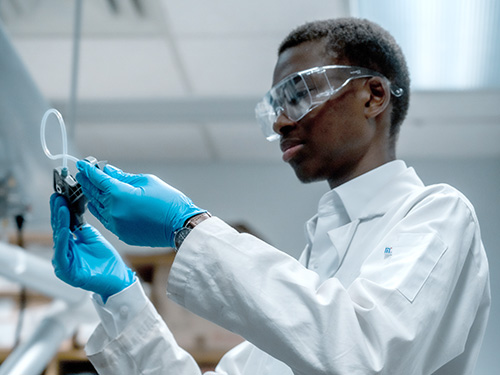
Here, Zandamela holds a capillary electrophoresis laser-induced fluorescence apparatus at the Zandberg Lab at UBC Okanagan.
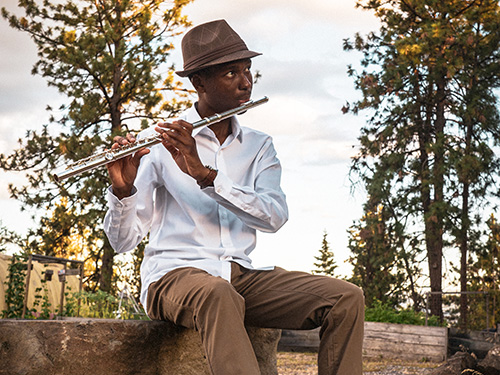
Zandamela improvising on his flute at the Old Pond Trail at UBC Okanagan.
The post Work Study opens new doors for undergraduates appeared first on UBC Okanagan News.
AS FAR BACK AS SHE CAN REMEMBER, Dr. Tamara Freeman has loved science. An early experiment as a toddler had her trying to figure out how a heart worked, as she pumped water between her palms. In Grade 10, when the general topic of science was expanded into areas like biology and physics, it was chemistry that captured Dr. Freeman’s imagination.
“When we started doing hands-on experiments, I would be right at the front of the classroom,” says Dr. Freeman, now an Associate Professor of Teaching in the Department of Chemistry. “Watching the colours of lemon and cabbage juices change as they were mixed in a simple pH indicator experiment; it was just magical to me.”
Her fascination with chemistry led Dr. Freeman to a Bachelor of Science in her hometown at the University of Victoria and a PhD at UBC Vancouver, where she discovered how much she enjoyed the teaching aspects of chemistry.
This awareness, combined with some serendipity, put Dr. Freeman on the road to teaching. She is now the first-year coordinator of lectures and laboratories at UBC Okanagan, an educator in first- and second-year chemistry courses and the Department of Chemistry’s first and only member of UBC’s Educational Leadership faculty stream. Always a favourite with her students, she has endeavoured to keep that magic she first felt in high school alive and thriving in her classroom.
“I want people who don’t think chemistry is important to them—or wonder when they’ll ever use it in life—to get a little more excited about it, and the beauty of science. At the end of my course, it’s not about how much chemistry the students know, but the fact that they care about chemistry and what it can do.”
Dr. Freeman wears her passion for chemistry quite literally on her sleeve, as evidenced by the vibrant colours of her tie-dyed lab coat. And while she may make the drawing of Lewis structures seem like art class or encourage spontaneous in-person or virtual dance parties for her hundreds of students, there is method to her madness.
Dr. Tamara Freeman.
“There are things that students value in a professor externally, like charisma and showmanship. I think that comes from my background in community theatre. But I also care for my students. I genuinely want them to succeed. Empathy has been important over the past couple of years. I’ve shared my struggles with my students, let them know I’m human.”
Early in 2022, Dr. Freeman was awarded the Margaret-Ann Armour Award for Early Career Chemistry Education by the Chemical Institute of Canada. This award recognizes her outstanding contributions to undergraduate education in chemistry.
A first-year chemistry course is as much about learning how to be a university student as it is about chemistry. “Those classes are made up of a diverse group of future engineers, artists, and all sorts of students with all sorts of academic and career aspirations,” says Dr. Freeman. “Not many are there to be career chemists.”
With this in mind, she asked herself, “Who am I teaching? First-year or fourth-year students?” She saw the potential to re-examine what the course content should be for a general chemistry course.
In collaboration with UBC Okanagan’s science librarians, Dr. Freeman implemented an online module where students learn the fundamentals of research from the most basic “what does peer review mean?” to proper source citation and how to write a formal term report. “This information is of value to all students embarking on their academic career,” she says, “but traditionally there hasn’t been room for it in the curriculum. Together we made it work.”
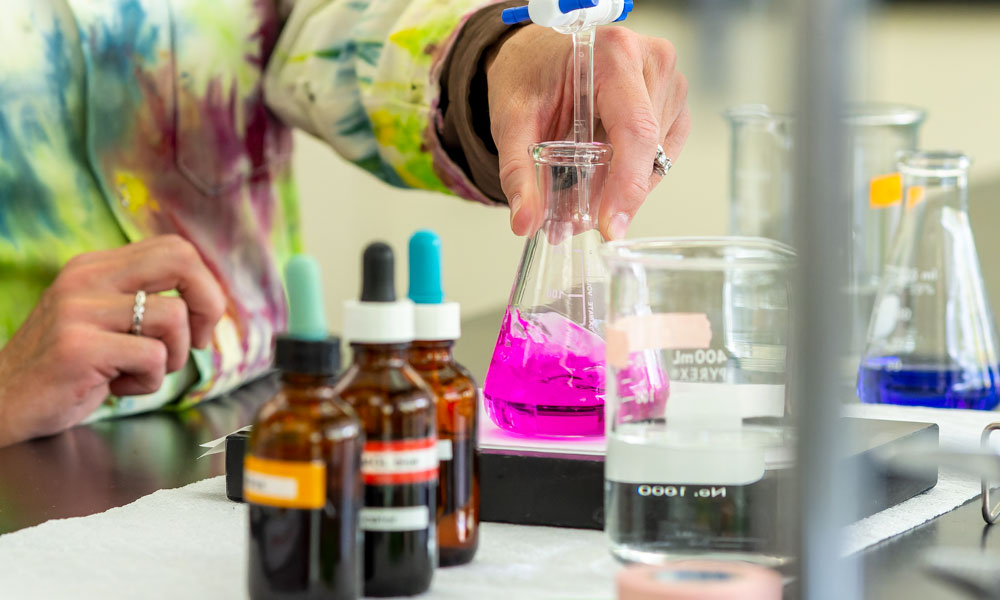
In addition to her changes to the first-year chemistry curriculum, Dr. Freeman was the faculty lead for UBC Okanagan’s LearnSmart program, which provided students with the knowledge, resources and strategies to achieve their academic goals. Supported by the Office of the Provost, it is housed in the Learning Hub. “We found that students had positive gains in their attitudes towards studying through their understanding of the resources available to them on campus,” says Dr. Freeman.
Perhaps one of Dr. Freeman’s most high-profile contributions to UBC Okanagan and the surrounding community is her popular Chembassador Chemistry Outreach Program. Here, a group of student volunteers supervised by Dr. Freeman engage the chemistry uninitiated in open house events exploring hands-on activities and the occasional explosive demonstration.
“Chemistry outreach is so important. I want to get people of all ages excited about things that are important to them, whether they know it or not.” Dr. Freeman says. “Like the fact that bananas are made up of just as many unpronounceable chemicals as junk food. We strive to communicate what we know about the world in a language that everyone can understand and in topics they care about.”
When not working, you might find Dr. Freeman curled up with a book or taking advantage of the Okanagan outdoors as she and her husband share the joys of camping and kayaking with their young children.
“Kelowna’s outdoor experience is wonderful in all its seasons,” she says.
“What I love about UBC Okanagan is that we have the big UBC name, but we’re on a campus where it’s easy to make connections. In my job, what could be better than being part of a world-renowned university on a campus where students know me by my first name?”
The post Dr. Tamara Freeman shares the magic of chemistry with her students appeared first on UBC Okanagan News.
KYLE LARSON’S CAREER TRAJECTORY PERFECTLY REPRESENTS the power educators have in the lives of their students. Growing up, Dr. Larson didn’t know what he wanted to be—only that he wanted a PhD—until a series of influential teachers set him on a path to ultimately studying the Himalaya.
“I had a high school teacher who was kind of like an anti-teacher—he didn’t ‘make’ us learn, but instead he talked to us and told us stories that incorporated different aspects of Earth Sciences,” explains Dr. Larson, now a Professor of Earth, Environmental and Geographic sciences at UBCO. “I found the way he presented the material really engaging and as a result, I found the material itself engaging. For me, teachers like him stand out.”
Later on, during his undergrad, Dr. Larson was fortunate to be involved with a researcher in Structural Geology and mountain building. Aside from the subject matter—which fascinated Dr. Larson—he also discovered some less-than-obvious benefits of studying Earth Sciences while working alongside the professor as a field assistant: “We would take a helicopter into the mountains in the Yukon and stay there for a couple of weeks. I thought to myself, ‘I can go camping for a living? This sounds all right—I can do this!’”
However, this fieldwork—along with a subsequent role with the BC Geological Survey—also taught Dr. Larson the breadth of knowledge and education needed to be a scientist and “make sense of the world.” After graduating with a Master of Science and trying to enter a lagging job market, Dr. Larson continued in academia for his PhD after learning that a Queen’s University professor was searching for a graduate student to study mountain building in the Himalaya.
Looking northeast up the Lhotse Glacier toward Imja Tse (centre-right; 6,189m) and Lhotse (left; 8,516m).
Now, almost 15 years later, Dr. Larson has visited the Himalaya 14 times in the pursuit of research, hoping to understand how the Earth’s crust deforms where its tectonic plates collide to form mountain ranges. “Typically, what I do is look at the rocks that were deformed during mountain building and try to gain evidence about the processes involved in accommodating the convergence of two different tectonic plates.”
For Dr. Larson, the Himalaya is a perfect research base because it’s a relatively young mountain belt; still actively forming, the range is preserved and hasn’t eroded away like some other ancient belts formed hundreds of millions of years ago.
“We use the mountain range as a natural laboratory, looking at rocks and how they fit together—much like pieces of a 3D puzzle. We see the end part of the puzzle, which is complicated, and then we try to break it down to its individual components and rebuild what geology has done over millions and millions of years.”
Of course, in Dr. Larson’s line of work collecting rock samples is critical and he has one special piece in his collection. “I have a rock specimen from the summit of Mt. Everest for a study we’ve just completed. Sometimes, I put it on the floor and stand on it, just to say I stood on the summit of Everest,” he jokes.
Using novel methods co-developed in the Fipke Laboratory for Trace Element Research (FiLTER), Dr. Larson and his team have made a series of fundamental discoveries about how major mountain belts form. One method involves examining the radioactive decay of the element rubidium to strontium using state-of-the-art laser and spectrometry instruments.
“People have been looking at these elements for decades, but you could only do it by dissolving minerals and separating them using an incredibly labour-intensive process. Now, we can figure out the ages of these rocks by putting the minerals that contain those elements under a laser and then examining how much rubidium has broken down into strontium,” explains Dr. Larson.
“I’ve felt nothing but support from people on campus. They’re always there to help and are invested in the outcomes of what you’re doing…. It really feels like the campus is invested in success, and people who work here day-in and day-out strive to make it happen.”
Another study from the lab, led by recent doctoral graduate student Dr. Iva Lihter, used the chemistry of minerals to model how the Himalaya evolved. Dr. Lihter was able to show that some of the minerals scientists have been using for decades to inform their models are potentially 450 million years too old to be part of the Himalayan system.
“A finding like this provides caution,” says Dr. Larson. “Now we know we have to be aware of this and can’t assume, carte blanche, that everything we see in the rock record is related to what is currently happening in the Himalaya.”
In recognition for the innovative work Dr. Larson and his team are currently exploring at FiLTER, Dr. Larson received UBC Okanagan’s Researcher of the Year award for Natural Sciences and Engineering.
He notes that UBC Okanagan’s smaller campus size and close-community feel have helped enable interesting conversations that led to multiple successes. For example, “The equipment that a lot of the FiLTER lab work has been done on was purchased outside of typical grants, thanks to conversations with people in the Vice-Principal, Research and Innovation office. The few degrees of separation between researchers and the people who can enable that research is so important.”
“I’ve felt nothing but support from people on campus,” Dr. Larson adds, “They’re always there to help and are invested in the outcomes of what you’re doing. There’s always someone to talk to about a problem or opportunity and more times than not, we’re able to come to a positive outcome. It really feels like the campus is invested in success, and people who work here day-in and day-out strive to make it happen.”
The post In the company of giants appeared first on UBC Okanagan News.
AS THE SEARING FLAMES LICK AT THE LODGEPOLE PINES AND KINDLING MOSS, Jeffrey Nishima-Miller works alongside his fellow firefighters to keep the wildfire contained. He’s trying to prevent the flames of the Elephant Hill fire—90 kilometres west of Kamloops—from ravaging nearby ranches, towns and Indigenous communities, where thousands of British Columbians make their living off the land.
That was the summer of 2017 and like many university students across the country, Nishima-Miller—now a doctoral student at UBCO—spent his summers working for the BC Wildfire Service. He’s battled some of the province’s most severe fires. But now, as a researcher exploring how Indigenous communities can create their own wildlife strategies, Nishima-Miller is using past experiences to inform his work. He’s seen first-hand that too many of BC’s forests are “begging to be burned.”
“It’s not surprising what we’re seeing in terms of the size and severity of wildfires. There’s this new reality of climate change and enormous fuel loads in the forests, along with a lot of bug-kill wood,” says Nishima-Miller. “It’s not a good situation; the result is a lot of fires in a short period that are bigger, more intense and hotter than ever, and that move fast across the landscape.”
It didn’t use to be this way.
In the early 1980s, Dr. Kevin Hanna, Nishima-Miller’s doctoral supervisor, worked as a firefighter in the then Ministry of Forests. At the time, there was an emphasis on year-round locally based management to prevent wildfires, often involving community members with fire experience.
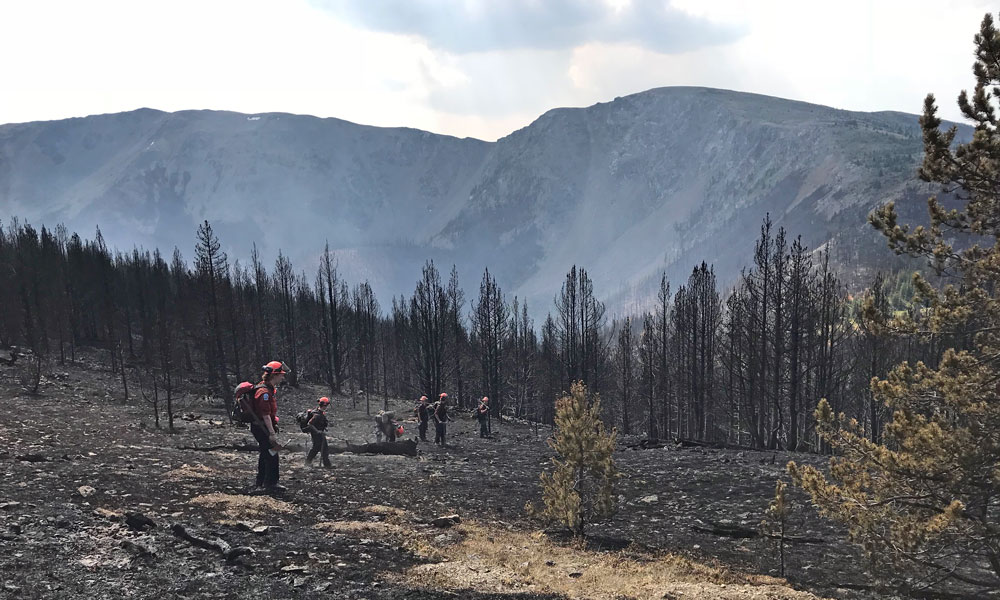
Here, a patrol looks for any hot spots still left smouldering from a recent forest fire.
“That’s one of the biggest changes I’ve seen; a lot of the fire suppression and firefighting was directed by the local level,” explains Dr. Hanna, an Associate Professor of Earth Sciences at UBCO and Director of UBC’s Centre for Environmental Assessment Research. He is interested in the risks that wildfire can pose for infrastructure and how the potential for forest fires needs to be considered in the planning, engineering and construction of major projects like pipelines or highways.
“If there was a big fire—and big fires like we see today were rare in those days—we often drew on local people who had training and experience. But what we’ve seen over the years is less local engagement and control, and more centralization of fire suppression, which has shown advantages and disadvantages.”
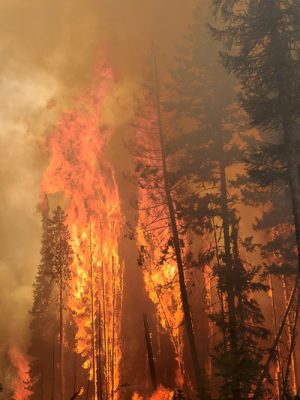
Photo courtesy of Jeffrey Nishima-Miller.
Dr. Hanna notes that although today’s forests are very different due to climate change, in his day the closeness of ranchers and Indigenous peoples to forested areas benefitted firefighting directly. “We worked closely with people who lived and worked on the land. In a fire, they were the ones who could tell you which places to worry about or not, and what the best routes to move equipment and people. They knew who to call when nearby equipment was needed.
“It’s revealing for me to look back and see how we might be able to take that knowledge and experience, and use it going forward,” says Dr. Hanna, adding it’s time to rediscover the value of engaging communities and local people in addressing wildfire risks.
Dr. Mathieu Bourbonnais, an Assistant Professor in Earth, Environmental and Geographic Sciences at UBCO, echoes the need to change course.
“The current way wildfires are managed is very much founded in Eurocentric approaches and landscape management that focus solely on fire suppression,” explains Dr. Bourbonnais, who—like Nishima-Miller— served as a wildland firefighter in the late 2000s.
In fact, it was those initial firefighting experiences that propelled Dr. Bourbonnais to graduate school and into academia. His fascination with the geomatics in his daily fire briefing packages led to studies in geographic information sciences, remote sensing and statistics. Today he focuses on understanding fuels and fire behaviour, how forests, ecosystems and wildlife may respond in the future, and how to design proactive mitigation to absorb impacts.
“In 2021, BC spent $800 million fighting wildfires, and the combined bill for the major fire seasons in 2017, 2018 and 2021 will likely be over $2 billion in fire suppression costs. Compare this to the approximately $30 million, for example, that’s annually available to communities for fire prevention work. So, there’s a scale element here that doesn’t match.”
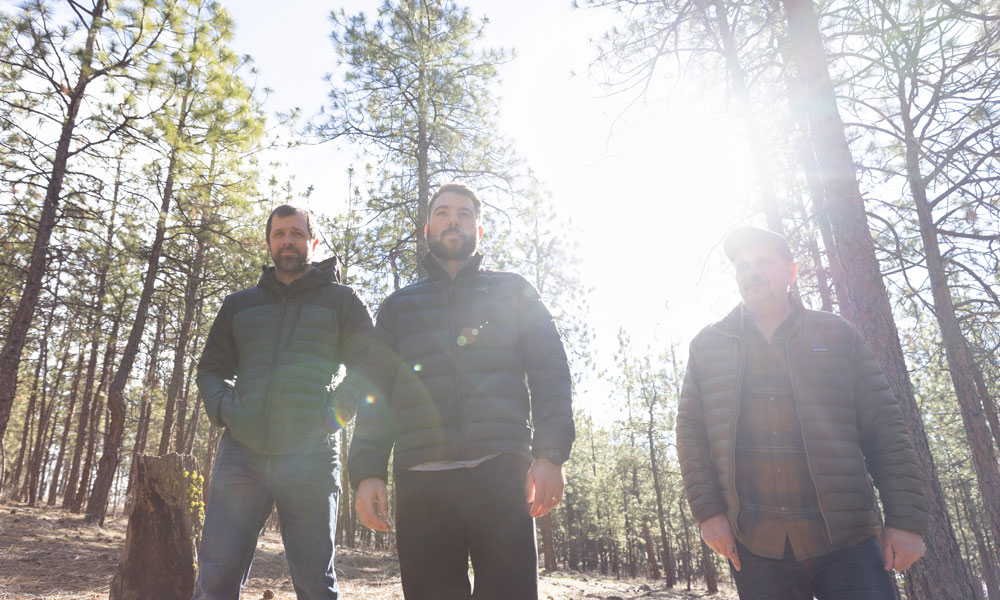
Dr. Mathieu Bourbonnais, Jeffrey Nishima-Miller and Dr. Kevin Hanna.
Although Dr. Bourbonnais, Dr. Hanna and Nishima-Miller have experienced different periods of firefighting and fire management stretching across nearly four decades, their experiences all point in the same direction: society needs to shift its idea of how to get ahead of the wildfire challenge.
“The fires I see now are not the same fires I fought 10 to 15 years ago,” says Dr. Bourbonnais. “It’s a different beast, so we need to explore the idea of collaborating more with communities. We also need to realize that we can’t look to our recent history for what to expect with future fire seasons, because the idea that more fire suppression will fix the problem doesn’t seem like it will work.”
Dr. Hanna points to examples in BC’s Cariboo and Chilcotin regions, where Indigenous communities and local ranchers have taken a role in fire prevention on their lands. Using their own equipment, logging skills and knowledge of the region, they proactively work to protect the land and their livelihoods. “They know their area intimately, and have a personal interest in working to help prevent and respond to wildfires.”
Dr. Bourbonnais says addressing climate change also plays a huge part in tempering wildfire trends. Although climate change is a global challenge, there are issues that can be addressed more immediately and locally.
“Changing how we manage fuels, fires and landscapes are things we can address right now. When people talk about the fire situation being too big to tackle, we actually have many of the mechanisms. We have policies, we have people who can do the work—including prescribed burning and thinning—and we have the knowledge. But unfortunately, we’re not harnessing this to our advantage.”
As for Nishima-Miller—the youngest of the three and the one who has fought some of the most severe wildfires in BC’s history—he’s optimistic.
“There’s still so much work left to do but I hope these recent severe wildfire seasons make things better in terms of areas that needed to burn.”
While all three see promise in BC’s recent move to a year-round wildfire service, they also note that if society is going to meet the challenges facing it today and in the years to come, there needs to be better use of local knowledge and skills, and more openness to new approaches to wildfire management.
The post Catching fire: BC wildfires are bigger, hotter and more consequential than ever appeared first on UBC Okanagan News.
